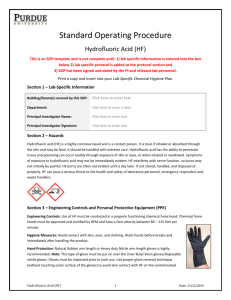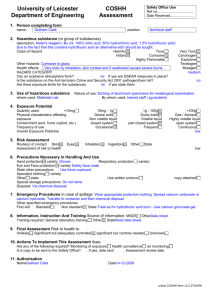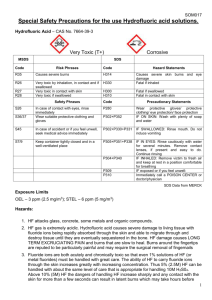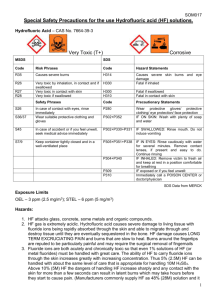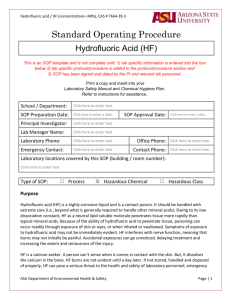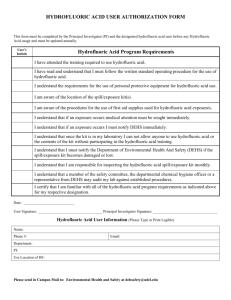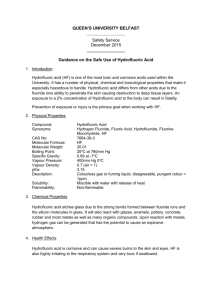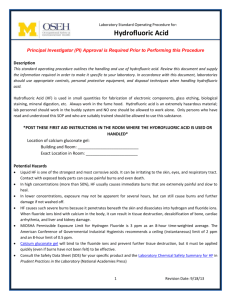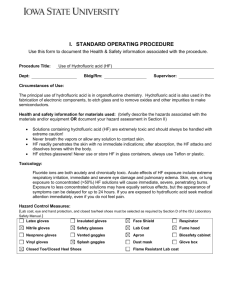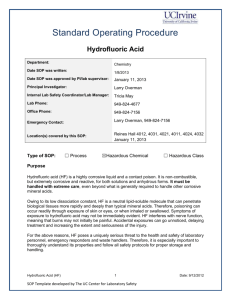Hydrofluoric Acid SOP
advertisement
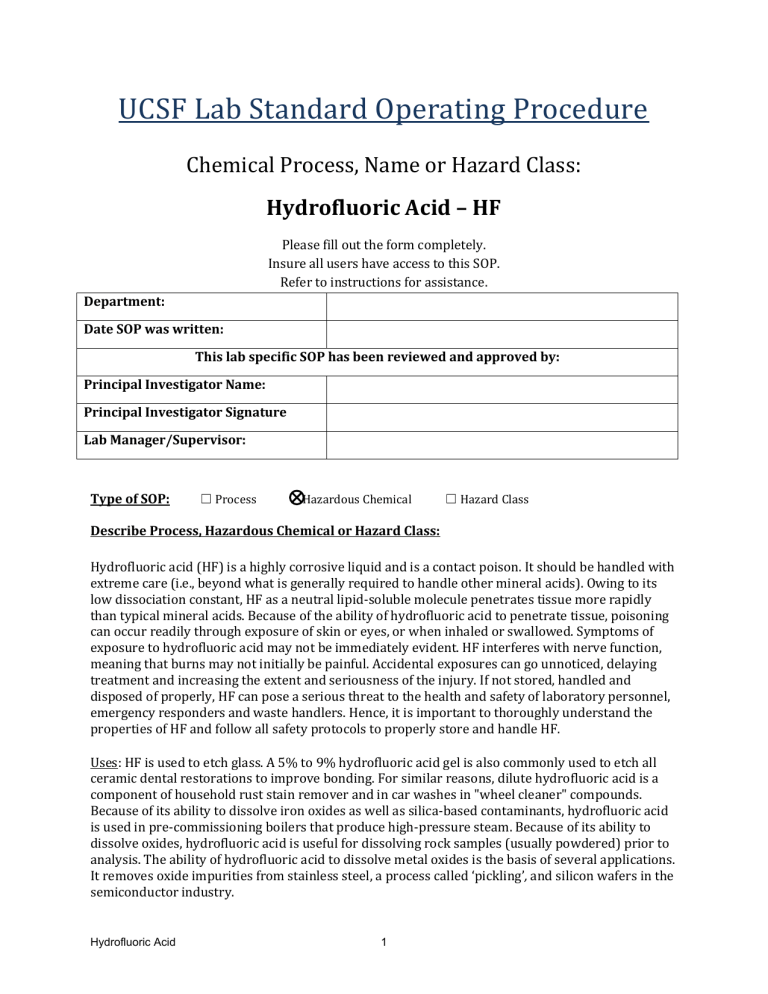
UCSF Lab Standard Operating Procedure Chemical Process, Name or Hazard Class: Hydrofluoric Acid – HF Please fill out the form completely. Insure all users have access to this SOP. Refer to instructions for assistance. Department: Date SOP was written: This lab specific SOP has been reviewed and approved by: Principal Investigator Name: Principal Investigator Signature Lab Manager/Supervisor: Type of SOP: ☐ Process ☐Hazardous Chemical ☐ Hazard Class Describe Process, Hazardous Chemical or Hazard Class: Hydrofluoric acid (HF) is a highly corrosive liquid and is a contact poison. It should be handled with extreme care (i.e., beyond what is generally required to handle other mineral acids). Owing to its low dissociation constant, HF as a neutral lipid-soluble molecule penetrates tissue more rapidly than typical mineral acids. Because of the ability of hydrofluoric acid to penetrate tissue, poisoning can occur readily through exposure of skin or eyes, or when inhaled or swallowed. Symptoms of exposure to hydrofluoric acid may not be immediately evident. HF interferes with nerve function, meaning that burns may not initially be painful. Accidental exposures can go unnoticed, delaying treatment and increasing the extent and seriousness of the injury. If not stored, handled and disposed of properly, HF can pose a serious threat to the health and safety of laboratory personnel, emergency responders and waste handlers. Hence, it is important to thoroughly understand the properties of HF and follow all safety protocols to properly store and handle HF. Uses: HF is used to etch glass. A 5% to 9% hydrofluoric acid gel is also commonly used to etch all ceramic dental restorations to improve bonding. For similar reasons, dilute hydrofluoric acid is a component of household rust stain remover and in car washes in "wheel cleaner" compounds. Because of its ability to dissolve iron oxides as well as silica-based contaminants, hydrofluoric acid is used in pre-commissioning boilers that produce high-pressure steam. Because of its ability to dissolve oxides, hydrofluoric acid is useful for dissolving rock samples (usually powdered) prior to analysis. The ability of hydrofluoric acid to dissolve metal oxides is the basis of several applications. It removes oxide impurities from stainless steel, a process called ‘pickling’, and silicon wafers in the semiconductor industry. Hydrofluoric Acid 1 In the lab, fluoride ions are also useful to examine the conductance properties of anion channels. Hydrofluoric acid is a primary source of fluoride ions for making metal halide salts for use in anion channel electrophysiology. Physical & Chemical Properties/Definition of Chemical Group CAS#: 7664-39-3 Class: Very toxic & Corrosive Molecular Formula: HF Form (physical state): Liquid Color: Colorless Boiling point: Not applicable Potential Hazards/Toxicity HF removes calcium from body in the affected area (Targets the bone) Target Organs - Liver, Kidney Potential Health Effects Inhalation Toxic if inhaled. Material is extremely destructive to the tissue of the mucous membranes and upper respiratory tract. Skin May be fatal if absorbed through skin. Causes skin burns. Eyes Causes eye burns. Causes severe eye burns. Ingestion May be fatal if swallowed. Engineering Controls Work with HF solution in a certified chemical fume hood and the airflow monitor is within acceptable limits. Insure sash height is positioned correctly at ~18 inches or less. Use the sash as a splash shield. Do not start nor continue an experiment if the fume hood is not working. Close the sash and contact EH&S immediately. Hydrofluoric Acid 2 Respirator Protection When a fume hood cannot be used, a half or full face respirator equipped with appropriate cartridges is required. Lab personnel intending to use/wear a respirator mask must be trained and fit-tested by EH&S. Personal Protective Equipment (PPE) Hand Protection Heavy neoprene, butyl or silver shield over nitrile gloves is highly recommended for large quantities, double nitrile gloves are required for smaller amounts. Gloves must be inspected prior to each use. Use proper glove removal technique (without touching outer surface of the gloves) to avoid skin contact with HF on the contaminated gloves. Dispose of inner nitrile gloves after use as hazardous waste. *Heavier outer gloves (neoprene, butyl, silver shield can be reused carefully (i.e., without touching the outer surface of the gloves). Wash hands thoroughly with warm water and soap. Apron and arm covering are recommended for splash protection. NOTE: Consult with your preferred glove manufacturer to ensure that the gloves you plan on using are compatible with Hydrofluoric acid. Refer to glove selection chart from the links below: UCSF Glove Selection Guide Ansell Chemical Resistance Guide Microflex Chemical Resistance Guide North Chemical Resistance Guide http://www.allsafetyproducts.biz/page/glove-selection-chart Eye Protection Tightly fitting safety goggles & face shield (ANSI approved). Skin and Body Protection Lab coat & natural rubber apron Full-length pants Closed-toe rubber or leather shoes Additional splash protection such as sleeves/ arm coverings A fitted lab coat should be worn. Laboratory coat sleeves must be of a sufficient length to prevent skin exposure while wearing gloves. As outlined in UCSF Personal Protective Equipment Policy, personnel should also wear full length pants, or equivalent, and close-toed shoes. Full length pants and close-toed shoes must be worn at all times by all individuals that are occupying the laboratory area. The area of skin between the shoe and ankle should not be exposed. Hygiene Measures Avoid contact with skin, eyes and clothing. Wash thoroughly after handling. Wash hands before eating. Remove contaminated clothing and wash before reuse. Hydrofluoric Acid 3 First Aid Procedures General advice ALL exposures should be evaluated immediately in an Emergency Department. Apply calcium gluconate (see below) and call 9-911 from a campus phone or 415-476-1414 from a cell phone to get assistance with transport to an Emergency Department. If inhaled Call 9-911 from a campus phone or 415-476-1414 from a cell phone to get assistance with transport to an Emergency Department. In case of skin contact Immediately irrigate skin with plenty of water while removing contaminated clothing and shoes. As soon as possible, apply calcium gluconate. Wearing compatible gloves, massage calcium gluconate gel into the affected area. Re-apply every 15 minutes until medical help arrives. Call 9-911 from a campus phone or 415-476-1414 from a cell phone. In case of eye contact Use the emergency Eyewash immediately, then apply 1% sterile calcium calgonate solution if available. Call 9-911 from a campus phone or 415-476-1414 from a cell phone. NOTE: Use the entire 120 ml content during an emergency (eye exposure). If swallowed DO NOT force someone to drink anything if they are having nausea or pain. Call 9-911 from a campus phone or 415-476-1414 from a cell phone. Special Handling and Storage Requirements All users must be personally trained prior to working with HF Ensure that you have all the PPE required for handling HF. HF must always be stored in plastic (nalgene / polypropylene) containers. DO NOT store HF in glass bottles/containers. Store in corrosive/acid storage cabinet within a secondary containment (nalgene/ polypropylene tray or tub). Do not store in the top most shelf of the storage cabinet. Note: In general, do not store chemicals at or above eye level. Ensure the container is tightly closed at all times. Do not store with oxides, organic chemicals, bases or metals. Hydrofluoric Acid 4 Carefully carry the stock bottle in a rubber maid bottle carrier/nalgene secondary container to the wet bench/chemical fume hood and pour out desired amount into a smaller container. Place stock bottle back in corrosive chemical storage cabinet with cap tightly closed. Lab buddy system is highly recommended when handling HF (i.e. someone who knows HF handling and emergency procedures should be nearby in the lab in case of emergency). Lab emergency contact information must be readily available. The lab personnel must have easy access to a telephone (landline or cell phone). Spill and Accident Procedure Chemical Spill Dial 9-911 from campus phone or 415-476-1414 from cell phone or 415-206-8522 (SFGH only) Spill – Assess the extent of danger. Assist contaminated or injured persons. Evacuate the spill area. Avoid breathing vapors. If possible, confine the spill to a small area using a spill kit or absorbent material. Keep others from entering contaminated area (e.g., use caution tape, barriers, etc.). Small (<1 L) – If you have training, you may assist in the clean-up effort. Use appropriate personal protective equipment and clean-up material for chemical spilled. Double bag spill waste in clear plastic bags, label and take to the next chemical waste pick-up. Large (>1 L) – Dial 9-911 from campus phone or 415-476-1414 from cell phone or 415-206-8522 (SFGH only) for assistance. Chemical Spill on Body or Clothes – Remove clothing and rinse body thoroughly in emergency shower for at least 15 minutes. See First Aid Procedures instructions above. Notify supervisor and EH&S at 415-476-1300. Chemical Splash Into Eyes –Use Calgonate Emergency Eyewash immediately. See First Aid Procedures instructions above. Notify supervisor and EH&S at 415-476-1300. Medical Emergency Dial 9-911 or 415-476-1414 Note: All serious injuries must be reported to EH&S at 415-476-1300 within 8 hours. Minor Injuries– Go to Occupational Health Programs (OHP) Clinic, 415-885-7580, 2330 Post Street, Suite 460 Hours of Operation for Appointments: Monday - Friday 7:30 a.m. - 4:00 p.m. (except Holidays). Note: All serious injuries must be reported to EH&S at 415-476-1300 within 8 hours. Needle stick/puncture exposure (as applicable to chemical handling procedure) – Wash the affected area with soap and water for 15 minutes. For mucous membrane exposure, flush the affected area for 15 minutes using an eyewash station. If experiencing pain or vomiting, call 9-911 for immediate transport to the nearest emergency department. If you have NO symptoms, have the SDS ready and contact the Poison Control Hotline at 1-800-222-1222 to determine if and what further care you may need. Hydrofluoric Acid 5 Decontamination/Waste Disposal Procedure HF is listed as Extremely Hazardous (EH) Substance by the State. Even the containers (irrespective of the size) which once held HF must be disposed of as hazardous waste with an on-line hazardous waste tag affixed on the container. Even the safety gloves that come in contact with HF (i.e., HF contaminated gloves) must be disposed of as dry hazardous waste. All dry hazardous waste must be double bagged (use only transparent bags) and affixed with an on-line waste tag. General hazardous waste disposal guidelines: Label Waste Affix an on-line hazardous waste tag on all waste containers using the Online WASTe Program https://ehs.ucop.edu/waste/ as soon as the first drop of waste is added to the container Store Waste Store hazardous waste in closed containers, in secondary containment and in a designated location Double-bag dry waste using transparent bags Waste must be under the control of the person generating & disposing of it Dispose of Waste Dispose of regularly generated chemical waste within 180 days Empty Containers o Dispose as hazardous waste irrespective of the container size Use secondary containment Safety Data Sheet (SDS) Location Online SDS can be accessed at http://www.fishersci.com/msdsproxy%3FproductName%3DA463500%26productDescription%3 DHYDROFLUORIC%2BACID%2BOPTIMA%2B500ML%26catNo%3DA463500%2B%26vendorId%3DVN00033897%26storeId%3D10652 Protocol/Procedure Quantities covered by this SOP: ___ ml to ___ ml Conditions covered by this SOP: ___oC – ___ oC Hydrofluoric Acid 6 General Overview and Purpose: Enter the experimental purpose Procedure: Enter experimental procedure. You can copy procedure from your lab notebook or from literature. NOTE Any deviation from this SOP requires approval from the Principal Investigator. Hydrofluoric Acid 7
